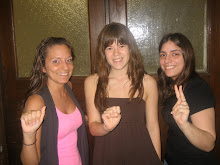Michael asked: I am wondering how many other types of sign language there are. Are they similar? If you know ASL can you learn another type quickly? Also, about how many signs are there? Are there signs for punctuation? Like a question mark for example.
Sarah’s Answer: Thank you for your questions! I divided them into three parts to more efficiently answer them.
How many other types of sign language there are? Are they similar? If you know ASL can you learn another type quickly?
I suppose that depends on how you want to define “type.” Sign languages, just like verbal languages, have been developing organically around the world for centuries, fulfilling the human need to communicate. So just as it is difficult to count the amount of spoken languages in the world, the same is true with sign languages. Furthermore, it would be hard to find characteristics that exist within ALL international sign languages, though a few elements likely crossover such as classifiers and facial expressions. However, sign languages around the world are just as diverse as verbal languages are!
Also, there are a few different “types” of sign languages in America. American Sign Language (ASL) is often mistaken to be a signed version of English. The reality is that ASL is a language all on its own, with distinct grammar and syntax, and very different from signed English. Also, there is tactile signing used among the deaf-blind population, and various types of signing techniques, such as method signing and pidgin English signing. In general, most of these types of signing are similar only in that they are signed and use some ASL vocabulary, but ASL is the only form that is itself a language.
As for learning other sign languages, I have often heard people say that after learning a verbal language it became easier for them to learn more. A friend of mine said the same thing about learning multiple sign languages: learning her second sign language was easier then learning her first, but she was still acquiring a whole new language which isn’t easy! Overall, the speed and ease of learning multiple languages largely depends on the individual.
How many signs are there?
Another good question! The short answer? There is no exact count for the number of signs in American Sign Language.
In ASL, there are many regional signs (think “couch” and “sofa” in English) and local signs (do you know what a “fudgie” is? You would if you were from Northern Michigan!), as well as dialects (such as Black American Sign Language which developed due to school segregation in southern states). Furthermore, one sign can have dozens of meanings, and most common signs have at least five inflections. All these variables make an exact count virtually impossible. However, I have heard that there are about 25,000 sign variations, depending on grammar and context. I had a tricky time finding a source to back that information up, but was able to find that number referenced on aslpah.com (an online journal for ASL students and teachers). Interestingly enough, I learned that there is also not an exact count for the number of words in the English language (AskOxford). That’s just the intricate and complex nature of languages for you!
Are there signs for punctuation? Like a question mark for example.
American sign language sentences are generally punctuated with pauses and facial expressions. While asking a question in ASL, the signer will most commonly raise his/her eyebrows and tilt their chin down. I have also seen signers repeat their question “word” (such as “where, bookstore, where”) or suspend their last sign to indicate the end of their question. Also, there is a sign for a question mark (you can see me signing that below!) but it is not used all that often.
Thank you so much for your great questions!!
